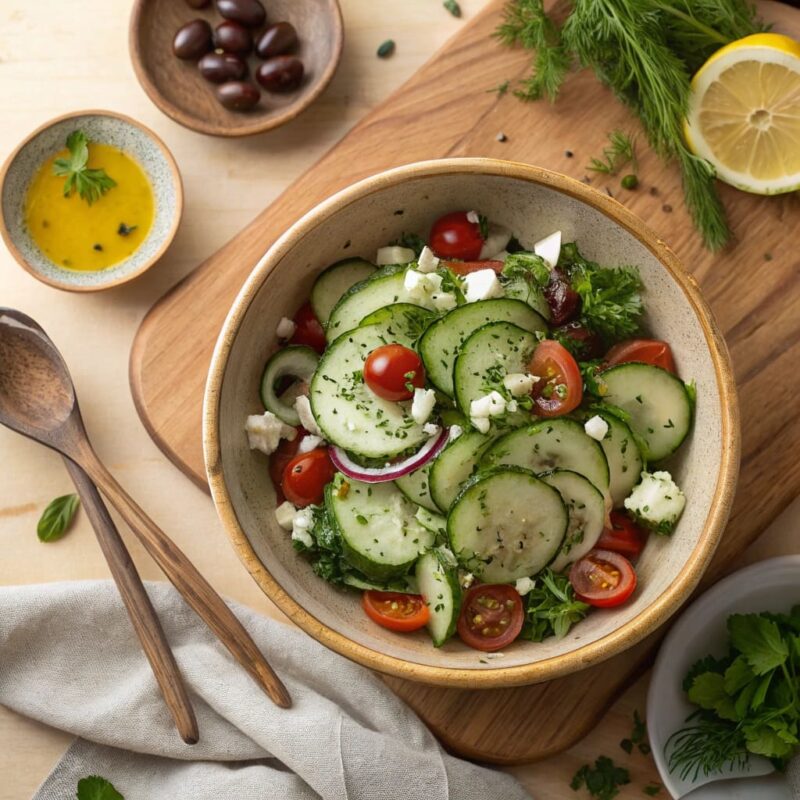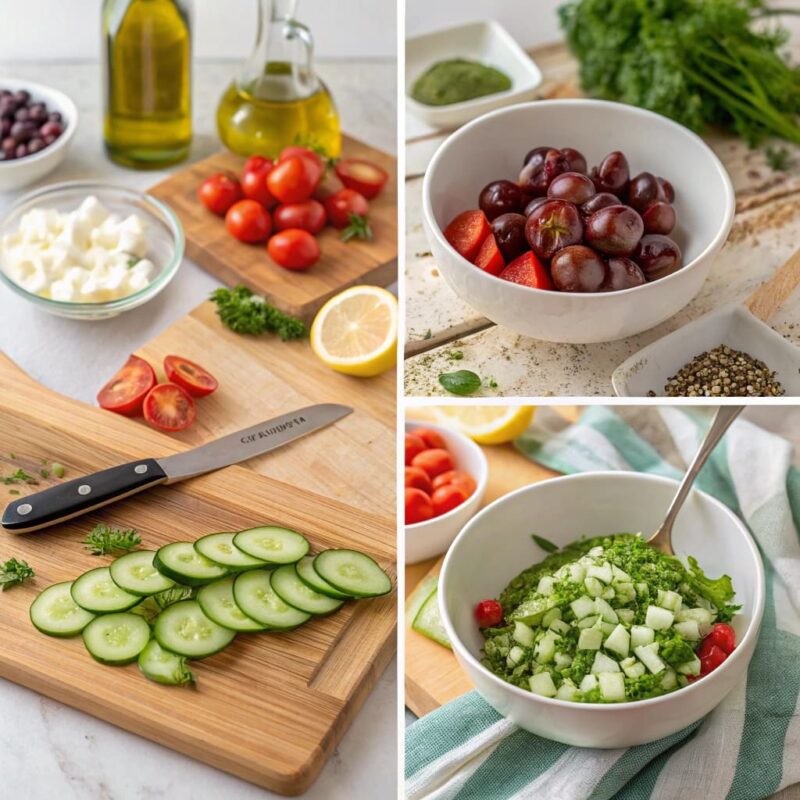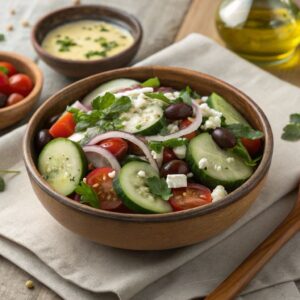Mediterranean cucumber salad is a vibrant, refreshing dish that captures the essence of Mediterranean cuisine. Whether you’re planning a light lunch, a side for a summer barbecue, or simply looking for a healthy and flavorful recipe, this salad is a perfect choice. Packed with crisp cucumbers, juicy tomatoes, tangy feta, and aromatic herbs, it’s an effortless yet elegant dish that suits any occasion. Let’s dive into why this salad stands out and how you can make it at home.

What Makes Mediterranean Cucumber Salad a Perfect Dish?
Mediterranean cucumber salad is a harmonious blend of taste, texture, and nutrition. Moreover, it’s incredibly versatile—you can enjoy it as a side dish with grilled chicken or fish, or as a standalone light meal. What’s more, what sets this salad apart is its simplicity: just a handful of fresh ingredients come together to create a dish bursting with flavor.
In addition, this salad celebrates the natural sweetness of cucumbers and tomatoes, the salty richness of olives and feta cheese, and the zesty tang of lemon juice or vinegar. Ultimately, it’s a dish that truly embodies the essence of Mediterranean cooking—simple, fresh, and healthy.
A Brief Overview of Its Nutritional Benefits
Not only is this salad delicious, but it’s also a powerhouse of nutrients:
- Low in calories: Perfect for those keeping an eye on their caloric intake.
- High in fiber: Promotes digestive health, thanks to the cucumbers and tomatoes.
- Rich in antioxidants: Fresh vegetables and herbs provide a boost of vitamins A, C, and E.
- Heart-healthy fats: Olive oil, a staple of Mediterranean cuisine, is loaded with beneficial monounsaturated fats.
This combination of flavors and health benefits makes Mediterranean cucumber salad a go-to choice for anyone seeking a delicious, nutritious meal.
Key Ingredients in Mediterranean Cucumber Salad
Crisp Cucumbers: The Star Ingredient
Cucumbers are the cornerstone of Mediterranean cucumber salad, providing a refreshing crunch that elevates the dish.
Choosing the Best Cucumbers for Your Salad
For the best results, choose seedless varieties such as Persian or English cucumbers. These options are naturally sweeter, less watery, and require minimal preparation. It’s best to avoid overly large cucumbers, as they may have tougher skins and bitter seeds, which can detract from the overall flavor.
How to Prep Cucumbers for Maximum Crunch
To ensure the cucumbers are at their best:
- Wash Thoroughly: Clean cucumbers under running water to remove any dirt or wax residue.
- Peeling for Texture Balance: If the cucumbers have thick skin, peel them partially to strike a balance between texture and flavor.
- Cutting for Consistency: Slice the cucumbers thinly or chop them into small cubes to ensure every bite is evenly flavored and satisfying.
- Refrigerate Before Cutting: Chill the cucumbers before preparing them to enhance their crispness and make the salad extra refreshing.
Tomatoes and Onions: The Supporting Cast
Tomatoes and onions add a burst of freshness and a complementary tang to the cucumber base.
- Adding Freshness and Texture
Juicy tomatoes bring natural sweetness and a vibrant color to the salad. Meanwhile, onions add a subtle bite that contrasts beautifully with the other ingredients. Red onions are the preferred choice due to their milder flavor and appealing color. - Balancing the Flavors with the Right Tomato Variety
Cherry or grape tomatoes work wonderfully for this salad, as they’re naturally sweet and have a firmer texture. Roma tomatoes are another excellent choice due to their low water content, ensuring the salad doesn’t turn soggy.
Olives and Feta: Mediterranean Staples
No Mediterranean dish would be complete without olives and feta cheese. These two ingredients bring a distinct salty, savory flavor profile to the salad.
- Why These Ingredients Define the Mediterranean Flavor
- Olives, especially Kalamata olives, provide a briny richness that complements the freshness of cucumbers and tomatoes.
- Feta cheese, with its creamy texture and tangy taste, ties all the elements together in a quintessentially Mediterranean way.
- Substitutes for a Dairy-Free Option
For a vegan or dairy-free version, consider substituting feta with cubed avocado or crumbled tofu seasoned with lemon juice and oregano. These alternatives provide creaminess without compromising the salad’s flavor.
Fresh Herbs and Simple Dressing
Herbs and dressing elevate Mediterranean cucumber salad, adding layers of flavor and aromatic depth.
- The Role of Parsley, Dill, and Mint
Fresh parsley is a must for its earthy flavor, while dill adds a hint of sweetness. Mint can be included for a refreshing twist. Together, these herbs create a fragrant medley that enhances the salad’s appeal. - Dressing Essentials: Olive Oil, Lemon Juice, and Vinegar
The dressing is a simple yet flavorful combination of extra-virgin olive oil, freshly squeezed lemon juice, and a splash of vinegar. Add a pinch of salt, black pepper, and dried oregano to tie everything together. For an extra kick, include a touch of minced garlic or a sprinkle of red pepper flakes.
How to Make Mediterranean Cucumber Salad
Making a Mediterranean cucumber salad is simple and rewarding, with just a few steps needed to create a dish that’s both delicious and nutritious. Follow this recipe to bring the vibrant flavors of the Mediterranean to your table.
Step-by-Step Recipe for a Classic Mediterranean Cucumber Salad

Ingredients:
- 2 English or Persian cucumbers, thinly sliced
- 1 cup cherry tomatoes, halved
- ½ red onion, thinly sliced
- ½ cup Kalamata olives, pitted and halved
- ½ cup crumbled feta cheese
- 2 tbsp fresh parsley, chopped
- 1 tbsp fresh dill, chopped
- 1 tbsp fresh mint, chopped
- 3 tbsp extra-virgin olive oil
- 2 tbsp lemon juice (freshly squeezed)
- 1 tsp red wine vinegar
- Salt and black pepper to taste
Instructions:
- Prepare the vegetables: Slice the cucumbers and tomatoes into uniform pieces for even texture. Thinly slice the red onion for a mild tangy crunch.
- Combine the base: In a large bowl, toss the cucumbers, tomatoes, onions, and olives.
- Make the dressing: Whisk together olive oil, lemon juice, red wine vinegar, salt, and pepper in a small bowl. Adjust the seasoning to taste.
- Assemble the salad: Pour the dressing over the vegetable mixture, then gently toss to coat. Sprinkle parsley, dill, and mint for freshness.
- Add feta: Crumble the feta cheese over the salad just before serving to keep it intact.
- Serve and enjoy: Serve immediately, or refrigerate for 30 minutes to let the flavors meld.
Tips for Achieving the Perfect Balance of Flavors
- Use fresh, high-quality ingredients to let the natural flavors shine.
- Balance the dressing by tasting as you go—adjust the lemon juice and olive oil ratio to suit your preference.
- Chill the salad before serving to enhance its crisp and refreshing qualities.
Variations of Mediterranean Cucumber Salad
One of the best things about Mediterranean cucumber salad is its adaptability. In fact, you can tweak the recipe to create exciting variations that suit different dietary preferences or occasions. For example, adding proteins or grains can make it more filling, while creamy dressings can offer a new twist. Ultimately, this flexibility allows everyone to enjoy the salad in their own unique way.
Adding Proteins
Transform your salad into a hearty main dish by incorporating proteins:
- Grilled Chicken: Thinly sliced grilled chicken adds lean protein and a smoky flavor.
- Chickpeas: For a vegetarian option, toss in a cup of cooked or canned chickpeas. Their nutty flavor complements the salad perfectly.
- Salmon: Add flakes of grilled or smoked salmon for a rich, omega-3-packed twist.
Grain-Based Versions
Grains can make this salad more filling and suitable as a standalone meal:
- Quinoa: Toss cooked quinoa into the salad for added protein and fiber. Its nutty texture blends seamlessly with the other ingredients.
- Bulgur: Soak bulgur in lemon water, then mix it in for a chewy, tangy addition that pairs beautifully with Mediterranean flavors.
Creamy Mediterranean Cucumber Salad
For a creamy version, replace the classic dressing with:
- Yogurt: Greek yogurt mixed with garlic, lemon juice, and a drizzle of olive oil creates a rich and tangy dressing.
- Tahini: Whisk tahini with lemon juice, water, and a pinch of salt for a nutty, dairy-free alternative.
Preventing a Watery Salad
Excess moisture can dilute the flavors of your salad, making it less enjoyable. Here’s how to keep your cucumber salad crisp and flavorful.
How to Make Cucumber Salad Not Watery
- Salt and Drain Cucumbers: After slicing, sprinkle cucumbers with a pinch of salt and let them sit for 15-20 minutes. This draws out excess water. Pat them dry before assembling the salad.
- Use the Right Variety: Opt for Persian or English cucumbers, which have thinner skins and fewer seeds, resulting in less water content.
- Serve Immediately: While the salad can be refrigerated briefly, serving it right after preparation helps maintain its texture and prevents it from becoming soggy.
Mediterranean Cucumber Salad vs. Other Mediterranean Salads
Mediterranean cuisine is known for its variety of salads, each with its own unique ingredients and flavors. Here’s how Mediterranean cucumber salad compares to its counterparts.
What Does a Mediterranean Salad Contain?
A traditional Mediterranean salad typically includes:
- Fresh vegetables like cucumbers, tomatoes, and onions.
- Herbs such as parsley and mint for added aroma.
- A simple olive oil-based dressing enhanced with lemon juice or vinegar.
- Optional additions like olives, feta cheese, or capers to boost flavor.
The defining feature of a Mediterranean salad is its reliance on fresh, seasonal ingredients and minimal processing.
What Is the Difference Between a Greek and Mediterranean Salad?
While Mediterranean and Greek salads share similarities, they differ in composition:
- Greek Salad: Known as “Horiatiki,” it traditionally includes cucumbers, tomatoes, onions, green bell peppers, olives, and a block of feta cheese on top. It’s served undressed, with olive oil and oregano drizzled at the table.
- Mediterranean Cucumber Salad: A more flexible dish that emphasizes cucumbers as the primary ingredient, often with a mix of herbs and a pre-made dressing.
Greek salad leans heavily on olives and feta, while Mediterranean cucumber salad offers more room for creative variations.
Pairing Mediterranean Cucumber Salad with Other Dishes
This salad is incredibly versatile. Pair it with dishes like Tunisian couscous with lamb for a hearty meal or enhance your dining experience by incorporating it into a larger Mediterranean spread with Mediterranean avocado toast.
Looking for more inspiration? Explore our collection of quick Mediterranean diet recipes to create a complete and satisfying dining experience with ease. Perfect for every occasion, these recipes will transform your mealtime into a Mediterranean feast!
As a Side Dish
Pairing this salad with grilled meats or seafood enhances its appeal as a complementary dish:
- Grilled Chicken or Lamb: The crisp, tangy flavors of the salad cut through the richness of grilled meats, creating a perfect balance.
- Seafood: Serve it alongside grilled salmon, shrimp skewers, or baked white fish. The citrusy dressing pairs beautifully with the delicate flavors of seafood.
- Mediterranean Platters: Combine the salad with dishes like hummus, baba ghanoush, and warm pita bread for a complete Mediterranean feast.
As a Light Main Course
Turn your Mediterranean cucumber salad into a satisfying main course by adding hearty elements:
- Bread: Serve the salad with crusty bread or pita to soak up the flavorful dressing.
- Grains: Add cooked quinoa, couscous, or bulgur for a more filling dish. These grains absorb the dressing, enhancing the overall flavor.
Health Benefits of Mediterranean Cucumber Salad
Mediterranean cucumber salad isn’t just tasty—it’s also a nutrient-packed dish that supports a healthy lifestyle.
Why This Salad Is a Powerhouse of Nutrients
- Low in Calories: Perfect for weight management, this salad is naturally low in calories and packed with satisfying ingredients.
- Rich in Antioxidants: Ingredients like cucumbers, tomatoes, and fresh herbs provide antioxidants that fight free radicals and promote overall health.
- Good Fats: The use of olive oil adds heart-healthy monounsaturated fats, which are beneficial for cardiovascular health.
- High Fiber Content: The fresh vegetables contribute to improved digestion and gut health.
How It Fits into a Healthy Lifestyle or Diet Plan
- Mediterranean Diet: This salad aligns perfectly with the Mediterranean diet, known for its focus on fresh produce, healthy fats, and balanced eating.
- Dairy-Free and Vegan Options: With a few tweaks, it can fit into vegan or dairy-free diets, making it inclusive for various dietary preferences.
- Meal Prep-Friendly: Make a large batch and store it for quick, healthy meals throughout the week.
Frequently Asked Questions
What Does a Mediterranean Salad Contain?
A Mediterranean salad typically includes fresh vegetables like cucumbers, tomatoes, and onions. Additionally, it features olives, feta cheese, and a simple olive oil and lemon dressing. To enhance the flavor, herbs such as parsley and mint are often added, giving the salad its signature aromatic touch.
What Is the Difference Between a Greek and Mediterranean Salad?
While both are similar, Greek salad features larger chunks of vegetables and often includes green peppers, with a block of feta cheese on top. Mediterranean cucumber salad uses cucumbers as the main ingredient, with more flexibility for variations and dressings.
How Do You Make Cucumber Salad Not Watery?
To avoid a watery salad, salt the cucumbers and let them sit for 15-20 minutes to draw out excess moisture. Pat them dry before assembling the salad.
How Long Can Mediterranean Cucumber Salad Be Stored?
The salad can be stored in an airtight container in the refrigerator for up to 2 days. For the best texture, store the dressing separately and combine it just before serving.
Can I Make Mediterranean Cucumber Salad Ahead of Time?
Yes, you can prepare the ingredients in advance and store them separately. Assemble and dress the salad just before serving to ensure maximum freshness and crunch.
Mediterranean cucumber salad is a celebration of fresh ingredients, vibrant flavors, and nutritional benefits. Moreover, its versatility makes it a great choice for any occasion—whether as a light main course, a refreshing side dish, or part of a larger Mediterranean spread.
In addition, with endless variations and its ability to fit into almost any dietary plan, this salad is a must-try for anyone looking to enjoy healthy and flavorful meals. So, why not experiment with different proteins, grains, or creamy dressings to make it your own? Surely, you’re bound to love the results.

Mediterranean Cucumber Salad: A Fresh and Flavorful Dish
Ingredients
For the Salad:
- 2 English or Persian cucumbers thinly sliced
- 1 cup cherry tomatoes halved
- ½ red onion thinly sliced
- ½ cup Kalamata olives pitted and halved
- ½ cup feta cheese crumbled
- 2 tbsp fresh parsley chopped
- 1 tbsp fresh dill chopped
- 1 tbsp fresh mint chopped
For the Dressing:
- 3 tbsp extra virgin olive oil
- 2 tbsp fresh lemon juice
- 1 tsp red wine vinegar
- ½ tsp dried oregano
- ½ tsp sea salt
- ¼ tsp black pepper
Instructions
Prepare the Vegetables:
- Wash and dry the cucumbers and tomatoes.
- Slice the cucumbers into thin rounds or cubes.
- Cut cherry tomatoes in halves.
- Thinly slice the red onion.
Assemble the Salad:
- In a large bowl, combine cucumbers, tomatoes, red onions, and olives.
- Add chopped parsley, dill, and mint for freshness.
Make the Dressing:
- In a small bowl, whisk together olive oil, lemon juice, red wine vinegar, oregano, salt, and black pepper.
- Taste and adjust seasoning if needed.
Combine & Serve:
- Drizzle the dressing over the salad and toss gently to coat.
- Sprinkle crumbled feta cheese on top before serving.
- Serve immediately or chill for 30 minutes for enhanced flavor.
- 💡 Pro Tip: For maximum crunch, refrigerate the cucumbers before slicing and dress the salad just before serving.
Variations & Add-Ons
- Protein Boost: Add grilled chicken, chickpeas, or flaked salmon for a heartier meal.
- Grain-Enhanced: Toss in cooked quinoa, bulgur, or couscous to make it a filling dish.
- Creamy Version: Mix the dressing with Greek yogurt or tahini for a creamy twist.
- Vegan Alternative: Replace feta with avocado or marinated tofu for a dairy-free version.
Storage Tips
- Refrigeration: Store leftovers in an airtight container for up to 2 days.
- Keep Crisp: Store the dressing separately and toss before serving.
FAQs
- Q: Can I make this salad ahead of time?
- A: Yes! Prep the ingredients in advance but add the dressing just before serving for the best texture.
- Q: How do I prevent cucumber salad from getting watery?
- A: Salt the cucumbers and let them sit for 15 minutes before assembling the salad. This helps remove excess moisture.
- Q: Is Mediterranean cucumber salad healthy?
- A: Absolutely! It’s packed with fiber, antioxidants, and heart-healthy fats, making it a nutritious choice.
Final Thoughts
- This Mediterranean Cucumber Salad is an easy, refreshing, and flavorful dish that perfectly complements any meal. Whether served alongside grilled meats, seafood, or enjoyed as a light main dish, it’s a crowd-pleaser full of fresh, wholesome ingredients.
- 🥗 Try it today and bring the flavors of the Mediterranean to your table!

10 thoughts on “Mediterranean Cucumber Salad: A Fresh and Flavorful Dish”